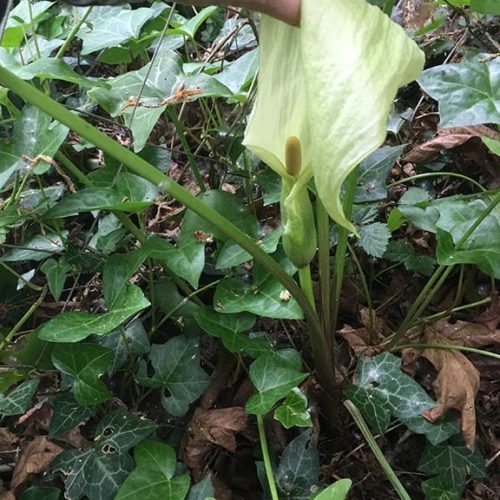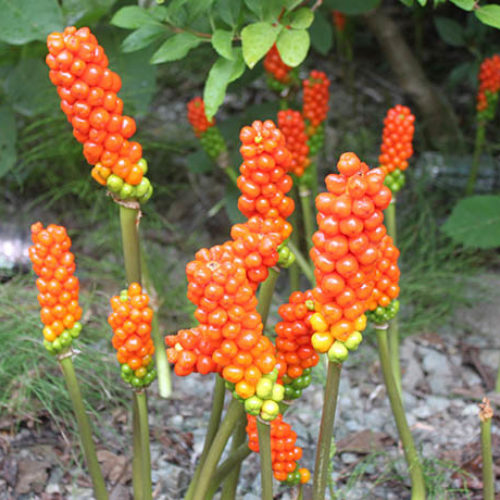Italian Arum

Italian Arum
(Arum italicum)
Priority: - Contain / Annual Control
Tags: Terrestrial | Toxic
Identification and Reproduction
Also called Orange Candleflower, Lords-and-Ladies, Italian lily, and Cuckoo’s pint, this is a popular horticultural plant found in gardens with the potential to spread beyond private properties.
Identification:
- Low growing herbaceous plant
- Leaves are arrowhead-shaped, green with cream/silver-grey veining. Leaves on young plants may be more oval-like and lack the veining. Leaves emerge in fall to late winter, dying back in the summer
- Flowers are made of a spathe and spadix, blooming in late April to June, and can give off a disagreeable odor.
- Fruits are tight clusters of berries, standing upright on the end of a stem. Berries start light-green and ripen to orange-red in late summer/early fall
- Roots are comprised of underground horizontal rhizomes and tubers buds, which multiply annually and easily break off to form new plants
Reproduction:
- Reproduction occurs via seed and tubers, and horizontal spread by rhizomatous roots
- Seed dispersal can occur via birds, ants and surface water.
Habitat & Ecology
Italian arum thrives in a variety of environments - closed to open canopy under variable soil and pH conditions. Typical habitat includes ornamental gardens, roadsides, natural areas including forests, riparian areas and wetlands. Once established, it can also tolerates drought.
Current occurrences are limited to temperate regions of BC, however this species can tolerate cold temperates and high latitudes and is likely capable of establishing in most region of the province.
Impacts
*All parts of this plant are highly poisonous to humans and animals, consumption may result in death. DO NOT CONSUME!
Social:
- Any part of the plant can cause severe skin irritation, illness, or death to people, livestock, and wildlife.
Ecological:
- Can shade out small native plants and keep other plants from
establishing
Management
Mechanical/Manual Control:
IMPORTANT: Due to the irritating toxins in the sap, stem, leaves, and fruits, it is advisable to wear gloves and other protective gear when handling Italian arum.
- For small infestations, careful digging can help to remove the plant - take care to not break tubers
- For suppression, cut and bag the fruit in August before seeds finish maturing
- Dispose all plant parts, fruits/seeds, tubers by placing in plastic bags and landfill - Do not compost
Chemical Control:
- Recent research showed that herbicide use (glyphosate, sulfometuron, metsulfuron, imazapyr, dicamba, and 2,4-D) can help kill the above ground foliage, but do not appear to affect the tubers
- There is little information on herbicide efficacy on this plant. Based on current knowledge, this species cannot be effectively controlled by chemical methods
Resources
See the King County Noxious Weed Control Program Weed page for Italian Arum or download the Italian Arum information brochure.
See Whatcom County's information sheet on Italian Arum management.
See Oregon State University's guide to getting rid of Italian Arum.
Note these are US resources and Canadian guidelines and regulations may differ. Be sure to read and follow product labels prior to use.
Header photo (Horticulture Centre of the Pacific/Victoria News).





